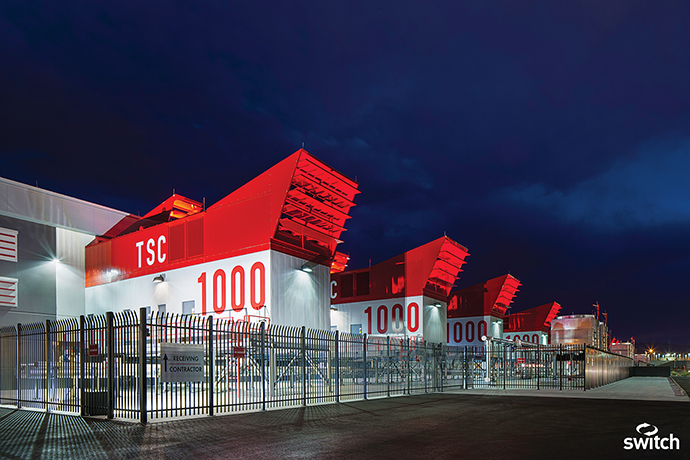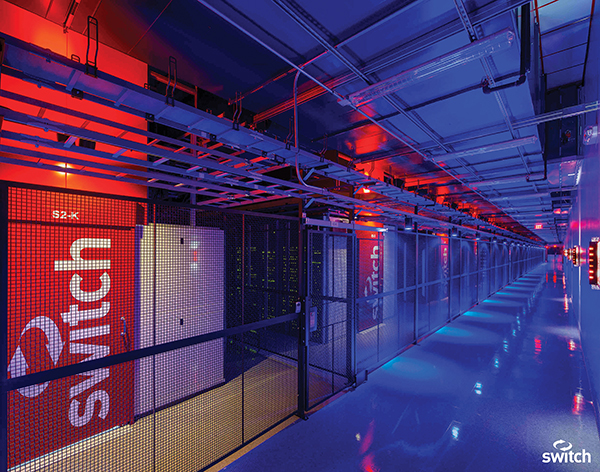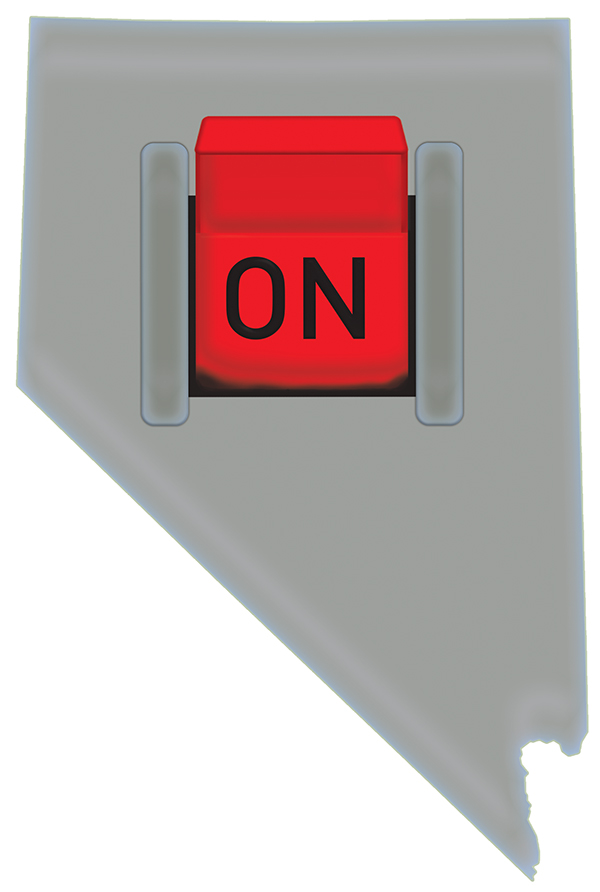We first heard of Switch seven years ago, when its SuperNAP broadband services hub in Las Vegas was beginning to benefit from the company’s 2002 auction purchase of Enron’s fiber node. The firm came up again in conversation earlier this year, when dark-fiber expert Michael Murphy, CEO of NEF, called their operation “very robust … and very eclectic.”
Today Switch is growing like never before in Nevada: The company just opened the doors of SuperNAP Las Vegas 9, a 470,000-sq.-ft. (43,663-sq.-m.) colocation data center that brings Switch’s total Las Vegas footprint to 1.5 million sq. ft. (139,350 sq. m.) Like its predecessor SuperNAP Las Vegas 8, the facility is targeting an average measured power usage efficiency (PUE) of 1.18, far below the industry standard. Additionally, Switch has stated a goal to run all of its data centers using 100-percent renewable energy through its G100 program.

“Switch was started with the idea that data centers needed to not only be able to handle the scale of the Internet but do so in the most efficient manner possible,” said Switch Founder and CEO Rob Roy, who invented the Wattage Density Modular Design (WDMD) system in 2005, holds 218 patents or patents pending, and famously does not grant interviews. “We want to power the next evolution of the Internet sustainably and with respect for our natural resources.”
The ribbon-cutting ceremony featured UNLV’s Metal Rebel robot, which Switch sponsored to compete in the 2015 U.S. Defense Advanced Research Projects Agency (DARPA) Challenge Finals in early June, where the team finished eighth out of 23 finalists. “Our team is excited to be here supporting technology growth in Nevada,” said Dr. Paul Oh, director of the drones and autonomous systems labs at UNLV’s Howard R. Hughes College of Engineering. “We’re excited to continue our ongoing partnership with Switch in making Nevada a U.S. technology hub.”
Switch’s SuperNAP Las Vegas 7 houses the Intel Cherry Creek Supercomputer that was awarded to UNLV in 2014 thanks to a sponsorship from Intel and Switch. Cherry Creek ranks among the world’s fastest and most powerful supercomputers.
Nevada Gov. Brian Sandoval in his 2015 State of the State address said Switch will make Nevada the most digitally connected state in the nation, a feat Switch says it has achieved. The first sector of SuperNAP Las Vegas 9 is already sold out, and construction has begun on SuperNAP Las Vegas 10 and 11, which together will add nearly 700,000 more sq. ft. (65,030 sq. m.) to the campus.
Switch is expected to open an additional three facilities in Las Vegas and up to seven facilities at its Tahoe Reno campus in the coming years, and will expand internationally as well. The company already has broken ground on the first of many international locations in Milan, Italy.
Site Selection recently conducted an email interview with Adam Kramer, vice president of government and public affairs for SuperNAP.
Site Selection: Why did Switch decide to build the SuperNAP data center in Reno?
Adam Kramer: Tahoe Reno 1, the world’s largest data center and our first SuperNAP facility at our Tahoe Reno campus, will open in the fourth quarter of 2015. It will allow our clients to run an active-active environment in dual Tier IV Gold data centers. These facilities are safely separated by more than 500 miles, achieving under 7 milliseconds of latency and still being located in low-tax, pro-business Nevada. Our first data center will be 1.2 million sq. ft. (111,480 sq. m.)with eBay as the facility’s anchor tenant. This expansion to a second campus location is in response to our global clients’ additional needs to run active-active in geo-diverse locations.
SS: How would you describe Nevada’s business climate?
AK: Nevada has a strong business climate. The state has no corporate income tax rates, an improving education system and policymakers are responsive to the needs of businesses.
SS: Would you predict more data centers moving to Nevada?
AK: What we can predict is more companies choosing to colocate at SuperNAP going forward. The availably of the only Tier IV Gold colocation data center environments in the world, both in Nevada, along with the $3-trillion cooperative buying power of Switch CORE, makes this the most unique data center and technology ecosystem in the world. It is a superior offering that cannot be matched by companies building their own facilities or any other colocation company that does not share the density, redundancy, sustainability and collaboration that the SuperNAP global clients have access to.
SS: If Switch expands again, will it be in Nevada?
AK: In short, yes. However, Switch is also actively looking to expand both nationally and internationally to fill our growing client demands. In Las Vegas, Switch has nine data centers, with plans for three more buildings on the current campus. This will give us more than 2.3 million sq. ft. (213,670 sq. m.) at a single, on-net, campus location. In Tahoe-Reno, we just finished grading our first 1.2-million-sq.-ft. (111,480-sq.-m.) site for the first of seven planned SuperNAP facilities to be located there for a total of 6.4 million sq. ft. (594,560 sq. m.).

We are also nearing completion of our SUPERLOOP, a fiber ring connecting Las Vegas to Reno, Reno to the Bay Area, the Bay Area to Los Angeles and Los Angeles back to Las Vegas, with only 7 milliseconds of latency between each location and more than 50 million eyeballs located within 14 seconds of either SuperNAP campus. We also plan to expand our position as a global leader in sustainability with large investments in renewable energy here in Nevada.
That last goal reached a milestone in July this year, when Switch, NV Energy, and the Regulatory Operations Staff of the Public Utilities Commission of Nevada (PUCN) announced a solution to Switch’s pending application to unbundle from the southern NV Energy system. As part of the settlement package, which requires PUCN approval, Switch’s growing energy load will be served from a new 100-megawatt solar photovoltaic project to be constructed by First Solar, north of Las Vegas.
The new solar facility, to go into commercial operation in late 2016 and be named Switch Station, will deliver renewable energy to the NV Energy transmission and distribution grid. Switch will pay a premium for 100-percent green energy under the NV Green Energy Rider tariff.
In addition, Switch will receive service under NV Energy’s High Load Factor tariff schedule, which recognizes the unique attributes of companies like Switch that run their facilities at steady, higher demands through the course of the day and all night long.
“Rob Roy and his team at Switch have built a world-class technology and innovation business that we are proud to partner with,” said Paul Caudill, NV Energy president and CEO, noting that discussions had been ongoing since 2014. “It is important to note that the new grid-tied Switch Station will be constructed and operated at costs that are being recognized industry-wide as among the lowest seen in the United States.”
What’s a Zettabyte?
In spite of Switch’s fondest dreams, other data centers — colo and otherwise — do exist. Nearly 20 percent of the approximately 1,360 projects tracked in the ICT sector by the Conway Projects Database since early 2012 are data centers. And they’re moving into the cloud faster than water from evaporating lakes.
Gartner says total cost of ownership for data center operations will decrease by 30 percent as soon as this year. By 2017, says IDC Data Center Predictions, 60 percent of datacenter-based IT assets will be in colocation, hosting and cloud data centers. And by the end of 2018, says Cisco’s Cloud Index Report, annual global data center IP traffic will reach 8.6 zettabytes. (A zettabyte is a measure of storage capacity and is 270 bytes, also expressed as 1021 or 1 sextillion bytes.)
Centers of gravity in this cloud-filled universe include Dallas-Fort Worth, where, in addition to big projects from Facebook (Fort Worth) and Equinix (Plano), new projects are afoot from T5 and Lincoln Properties, and from RagingWire, which is building a five-building data center campus in Garland with 16 MW of capacity.

“Dallas has the highest population growth in the country and the quick growth in the technology sector needed to support its data center market,” notes a recent report from CBRE’s data center practice. Northern Virginia surpassed New York/New Jersey in total data center square footage in 2014, and is forecast to keep its No. 1 spot in 2015.
JLL’s latest data center report, released in early October, also highlighted Dallas among 17 hot-spot markets it says offer the right “mix of lower tax obligations, utility pricing and demand,” including:
Chicago: “There has been an increase in demand for space in Chicago from West Coast technology companies who are developing sites for cloud hosting strategies in the Midwest. The Windy City also is No. 2 in data center construction with 345,595 sq. ft. [32,105 sq. m.] currently in development, just ahead of Silicon Valley, which has 236,000 sq. ft. [21,924 sq. m.] under construction.”
Dallas: “At 5 cents per kWh, Dallas provides one of the country’s most affordable major market utility rates. Further, Texas passed tax incentive legislation that provides 100-percent exemption of sales taxes on business personal property to operate a data center over 10 to 15 years for large users. This can equate to millions upon million in savings for a qualified project.” Missouri also recently passed new tax breaks for the sector for new projects involving at least $25 million invested and 10 jobs, or expansions that involve $5 million and five new jobs.
Minneapolis-St. Paul: “Demand is growing significantly and supply has never been higher, driven in large part by the burgeoning healthcare sector. Also, state data center tax incentives allow companies to abate sales tax on hardware, software and power by housing their data center in a qualifying facility.” Among the 17 markets studied, the Twin Cities, Northern Virginia and Austin/San Antonio were the only areas forecast to be user-favorable markets from Q2 2015 through Q2 2016.
Reno: “The Biggest Little City in the World is experiencing its first foray into data center development led by Apple, Switch and eBay due to an abundance of power specifically in renewable resources. Proximity to California customers and the new Nevada tax bill provide additional incentives.”
Toronto: “Supply has been a historical challenge for the Canadian data center market on the whole, but capital investment by Toronto Hydro within the financial core will help improve some of the city’s aging infrastructure. This will continue to draw interest in third-party data center space.”
Northern Virginia: At 31.8 MW, the area led North America in year-to-date data center space absorption in fall 2015. The area “surpassed the New York/New Jersey region in terms of operational data center square feet in 2014 and is on track to lead the US again in 2015.” The area’s 2015 cost of power, at an average of 5.7 cents per kilowatt-hour in 2015, is third-best of the 17 markets studied by JLL, after Dallas-Fort Worth (5.6 cents) and Atlanta (4.8 cents).
Seattle & Portland: With 24 MW of data center absorption year-to-date in 2015, these markets trailed only Northern Virginia and Silicon Valley in that category. They lead all regions in data center space under construction.

JLL further noted that major colocation providers are turning to M&A to keep pace with demand, highlighting the doubling of Equinix’s footprint with its $1.9-billion acquisition of Telx. High construction and infrastructure costs are another driver for M&A, said JLL, as well as for the shift from owned facilities to third-party providers by traditional enterprise users.
“Colocation is the choice for more enterprise businesses that had previously built, owned and operated their own facilities due to the upfront capital expenditure associated with building, maintaining and updating the equipment to stay current with new technology efficiencies,” said Mark Bauer, West Region lead for JLL’s Data Center Solutions, noting the flexibility and speed-to-occupancy colo affords end users.
Within North America, Portland, Toronto and the Twin Cities are catching up to traditional data center clusters in demand. The report noted that the large providers now also are looking oversees to emerging markets “where the mismatch between supply and demand can provide higher returns.”
Indonesia is an Asian hot spot, while investment interest in Europe is increasing in Stockholm, Vienna, Madrid and Milan (Switch’s chosen location), says JLL.
In other words, colo providers that have invested in massive new space on the chance that end users will make the switch may be making the right bets. That means Switch will continue to double down, in Vegas and abroad.

